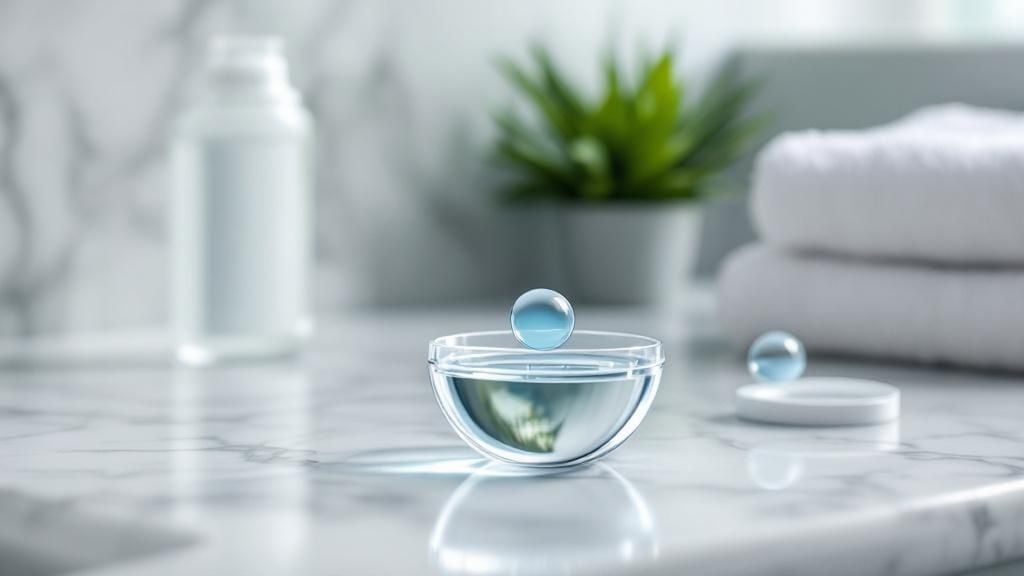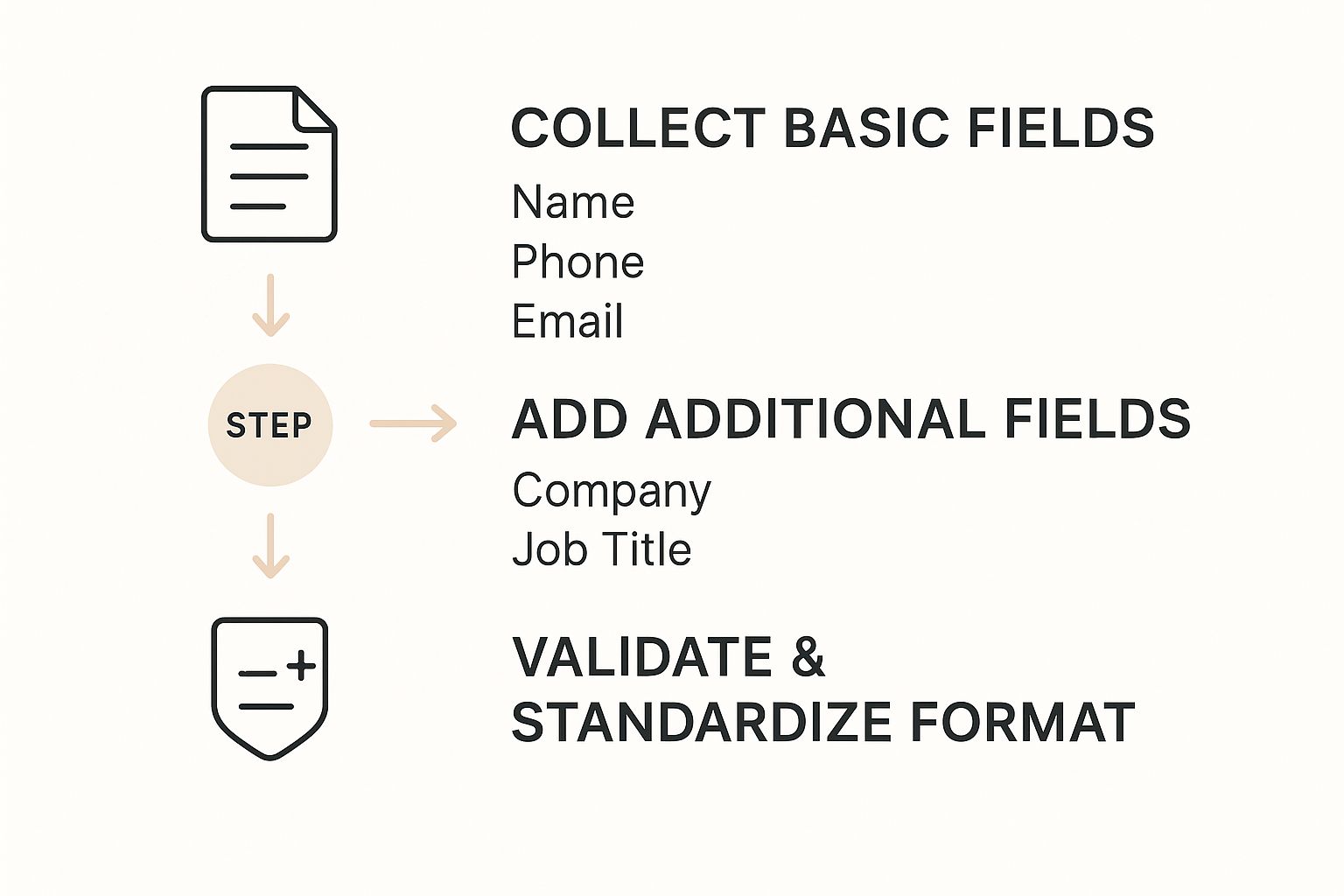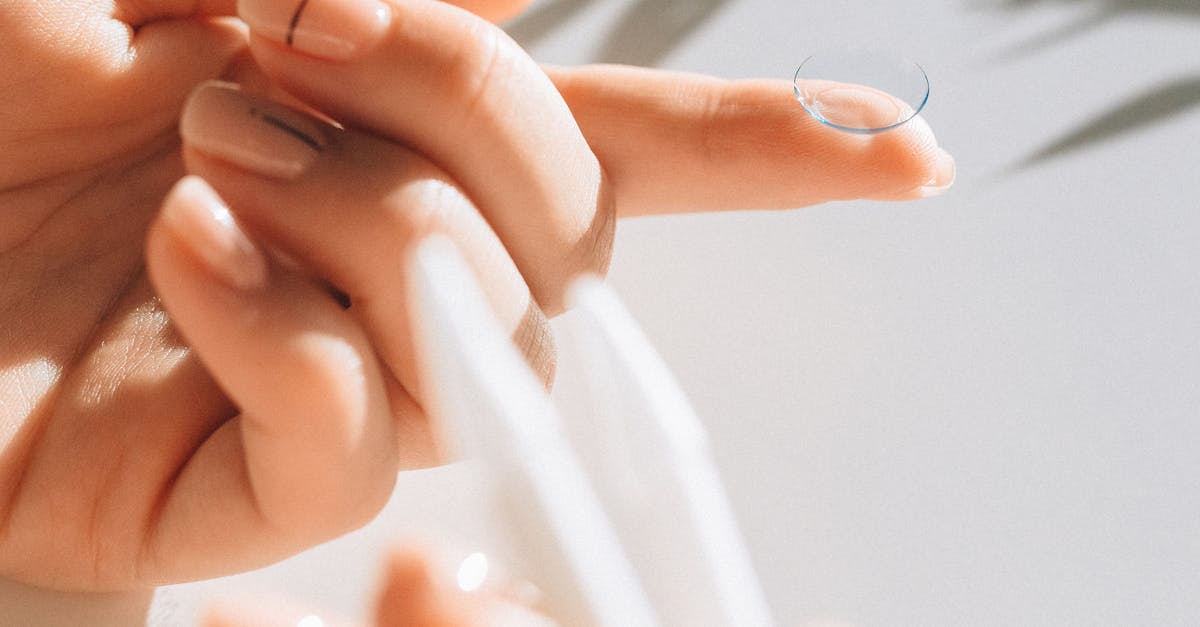If you wear contacts, think of your lens case as more than just a plastic container—it’s a medical device that needs just as much attention as the lenses themselves. Here in Glendale Heights, we teach our patients at iDoctor that storing your contacts properly every single night in fresh, sterile solution inside a clean case is the single best way to avoid painful eye infections and keep your lenses comfortable.
Skipping this crucial step, even for one night, can turn that case into a breeding ground for nasty bacteria and fungi.
Why Getting Your Contact Lens Storage Right is So Important
As an eye doctor, I've seen firsthand what can happen when storage habits get sloppy. It's not just about comfort; it's about protecting your vision from serious, long-term damage.
When you don't store your lenses correctly, you're essentially inviting microorganisms to a party on the surface of your lens. Putting that lens back in your eye can lead to some serious problems, like microbial keratitis. This is a severe infection of the cornea (the clear front part of your eye) that's not only incredibly painful but can cause permanent scarring and vision loss. It's a risk that's just not worth taking.
The Core Habits for Healthy Eyes
Building a rock-solid care routine doesn't have to be complicated. It really boils down to a few fundamental habits that should become second nature.
- Fresh Solution, Always: Never, ever "top off" the old solution in your case. Dump out every last drop, rinse the case with fresh solution (never tap water!), and then fill it with new solution before putting your lenses in.
- Clean Hands First: Before you touch your lenses or your case, wash your hands thoroughly with soap and water and dry them with a lint-free towel. This simple step prevents transferring germs directly to your eye.
- Don't Forget the Case: Your lens case needs a daily cleaning, too. After you put your lenses in, rinse the case wells with fresh solution, and leave it open and upside down to air-dry completely.
Proper storage is the cornerstone of safe contact lens wear. It’s a simple, two-minute routine that protects your eyes from potentially sight-threatening infections and ensures your lenses remain comfortable and effective.
For a quick reference, here’s a simple breakdown of the absolute do's and don'ts for overnight storage.
Contact Lens Storage At a Glance
| Action | Why It Is Important |
|---|---|
| Use fresh solution every night | Reusing solution allows bacteria and deposits from your lenses to thrive, increasing infection risk. |
| Wash and dry hands first | Prevents transferring dirt, oils, and germs from your fingers to your lenses and eyes. |
| Clean and air-dry the case daily | Stops the growth of biofilm—a slimy layer of bacteria—inside your case. |
| Replace your case every 3 months | Even with cleaning, cases can harbor bacteria over time. A fresh case is a clean start. |
| NEVER use water | Tap water contains microorganisms (like Acanthamoeba) that can cause severe, sight-threatening infections. |
Committing these simple actions to memory is the key to a lifetime of healthy and comfortable lens wear.
Once you’ve nailed down your storage routine, you can take your care to the next level. For more in-depth techniques, check out our complete guide on the best way to clean contacts to perfect your daily regimen.
Choosing Your Lens Solution and Case
Picking the right products to store and clean your contacts is just as critical as the cleaning routine itself. Your contact lens solution isn’t just saline—it's a sophisticated disinfectant engineered to keep your eyes safe. Using the wrong one can lead to anything from minor irritation to a serious infection.
Matching the Solution to Your Needs
When you come see us for contact lenses in Glendale Heights, we'll walk you through all the options. Generally, you’ll be choosing between two main types of solutions.
- Multipurpose Solutions: These are the all-in-one workhorses of lens care. They clean, rinse, disinfect, and store, making them incredibly convenient for most people who wear soft contacts.
- Hydrogen Peroxide-Based Systems: For those with sensitive eyes, these are a game-changer. They provide a deep, preservative-free clean but come with a critical rule: you must use the special case that neutralizes the peroxide before the lenses are safe to wear.
Your lens case isn't just a plastic box; it's a medical device. It needs the same level of care as your lenses to prevent a nasty buildup of bacteria.
Why Your Lens Case Matters
Think of your case as the first line of defense against contamination. Even the world's best cleaning solution won't do much good if you're putting your lenses into a grimy case every night.
To keep things clean, always rinse your case out with fresh solution—never, ever use tap water—and let it air-dry completely, upside down with the caps off. Do this every single day.
Most importantly, throw your old case out and start with a new one every three months. Bacteria love to build an invisible, stubborn film on the plastic called a biofilm, and it’s nearly impossible to scrub off. A fresh case is a clean slate. Getting these basics down is just as crucial as learning how to put contacts in for the first time.
A Healthy Nightly Contact Lens Routine
If there's one habit that makes the biggest difference for contact lens wearers, it's a solid nightly routine. It doesn't have to be a big production, but consistency is absolutely key. This is the same advice I give every single patient who comes into our Glendale Heights clinic for a contact lens fitting.
Your routine should always start before you even think about touching your lenses. Get to the sink and wash your hands thoroughly with soap and warm water for at least 20 seconds. Then, grab a clean, lint-free towel and dry them completely. This one simple step is your first and best line of defense against nasty eye infections.
The Rub and Rinse Method
With clean, dry hands, you're ready to handle your lenses. Carefully take one lens out and place it in the palm of your hand. Add a few drops of fresh contact lens solution right on top of it.
Now for the most important part: use the tip of your finger to gently rub the lens for about 15-20 seconds. Think of it like scrubbing a tiny dish—that gentle friction is what physically removes the film of proteins and grime that builds up during the day. After a good rub, give it a final rinse with a bit more solution to wash away all that loosened debris.
This is the tried-and-true method that keeps lenses clear and comfortable.
Seeing the process laid out—clean, rinse, store—really drives home how each step is crucial for getting your lenses truly disinfected.
Filling and Sealing Your Case
Once the lens is clean, pop it into the correct side of your lens case (L for left, R for right). Now, fill that little well with fresh solution until the lens is completely covered.
Here's a critical point: Never "top off" old solution. Reusing solution is like trying to get clean by bathing in yesterday's dirty water; it’s a huge gamble with your eye health and a fast track to infection.
Screw the caps on tightly and you're done. Let them soak overnight or for the minimum time listed on your solution's bottle. Sticking to this routine every night is the best way to keep your eyes safe.
A consistent nightly routine is non-negotiable. Taking these few minutes each evening ensures your lenses are disinfected, comfortable, and safe for your eyes the next morning.
7 Common Storage Mistakes You Might Be Making
Even if you’ve worn contacts for years, it's surprisingly easy to fall into bad habits. These little shortcuts might not seem like a big deal, but they can put your eye health at serious risk. Knowing how to store your contacts properly is just as much about knowing what not to do.
Let's talk about one of the most common—and dangerous—mistakes: "topping off" old solution. Think of it this way: your solution’s job is to kill germs and clean your lenses. When you just add a little fresh liquid to the old stuff, you're diluting its disinfecting power. This basically leaves bacteria to throw a party in your lens case all night.
It’s a direct invitation for an eye infection. The only right way is to dump the old solution, give the case a quick rinse with fresh solution, and then fill it up again. Every single time.
Habits That Can Seriously Harm Your Eyes
Beyond reusing solution, a few other risky behaviors can lead to everything from major discomfort to nasty corneal ulcers. It’s critical to spot these habits and stop them in their tracks.
- Using Tap Water: Never, ever let tap water touch your lenses or your case. It contains a particularly nasty microorganism called Acanthamoeba, which can cause a rare but devastating infection that can lead to vision loss.
- Stretching Your Lens Schedule: Trying to squeeze an extra week out of your two-week disposables to save a few bucks is a huge mistake. Over-worn lenses get caked with protein deposits, they don't let enough oxygen through, and your infection risk skyrockets.
- Forgetting About the Case: Your lens case is not a self-cleaning object. If you neglect it, it turns into a grimy home for bacteria. It needs a daily cleaning and should be replaced entirely every three months. No exceptions.
Key Takeaway: Most eye infections aren't just bad luck—they're the direct result of preventable storage mistakes. A few extra seconds of care each day is your best defense against days or even weeks of painful recovery.
Understanding the real-world consequences of these small slip-ups can be a powerful motivator for change. The table below breaks down the risks of common bad habits versus the simple, healthy alternatives.
Risks of Improper Storage vs Benefits of Correct Habits
| Improper Habit | Potential Risk | Correct Habit | Health Benefit |
|---|---|---|---|
| "Topping off" solution | Bacterial growth, eye infections, Acanthamoeba keratitis | Empty, rinse, and refill the case with fresh solution daily | Ensures lenses are properly disinfected and safe to wear |
| Using tap water on lenses/case | Severe infections from microorganisms like Acanthamoeba | Use only sterile contact lens solution for rinsing and storing | Prevents exposure to harmful water-borne pathogens |
| Not replacing the case | Biofilm buildup, a breeding ground for bacteria and fungi | Replace the lens case every three months | Eliminates a major source of contamination |
| Wearing lenses past their schedule | Corneal ulcers, inflammation, lack of oxygen to the eye | Adhere strictly to the replacement schedule (daily, bi-weekly, etc.) | Maintains eye health, comfort, and clear vision |
These small, seemingly innocent slip-ups can truly compromise the health of your eyes. For instance, that protein buildup doesn't just make lenses feel gritty; it can trigger significant inflammation. It's always best to follow the rules to keep your vision clear and your eyes healthy for the long haul.
How to Care for Your Contact Lens Case
Your contact lens case plays a huge role in keeping your eyes safe—it’s not just a plastic container. Think of it as a critical medical device. If you don't keep it clean, it can quickly become a breeding ground for nasty bacteria and other microbes.
Taking care of your case is straightforward, but you have to be consistent. Every single morning after you put your lenses in, dump out all the old solution. Don't just top it off. That's a major no-no.
Next, give the case a good rinse, but only with fresh contact lens solution. Never, ever use tap water. Tap water isn't sterile and can introduce dangerous microorganisms, like Acanthamoeba, which can cause serious eye infections.
Once it's rinsed, leave the case open and upside down on a clean tissue to air-dry completely. This simple step is your best defense against biofilm—that slimy, invisible layer of bacteria that loves to grow in damp environments.
Replace Your Case Every Three Months
Even if you follow this cleaning routine perfectly, you still need to swap out your case regularly. The CDC is clear on this: get a new one at least every three months.
Why so often? Over time, tiny, invisible scratches can form inside the case, and biofilm can build up in those crevices, making it almost impossible to fully disinfect. It becomes a permanent home for bacteria.
A new case is a small, inexpensive investment in your eye health. It’s one of the easiest ways to significantly reduce your risk of a painful eye infection.
This is one of the most important habits we teach people during our detailed eye exams in Glendale Heights. Of course, if you'd rather skip the cleaning and storage routine altogether, you could explore different types of daily contact lenses that you just throw away at the end of the day.
Your Partners in Eye Health in Glendale Heights
Mastering your contact lens storage habits is simply part of being a responsible wearer. It’s what allows you to enjoy clear, comfortable vision day in and day out without putting your long-term eye health at risk. If you ever find yourself with questions or just feeling unsure about your routine, the team at iDoctor is always here to help.
We're proud to be the best optometrist in Glendale Heights for our community, from families near Glenbard West High School to our neighbors over by the Glendale Lakes Golf Club. Think of us as your partners in maintaining a lifetime of healthy vision.
It’s interesting how the principles of safe storage apply to so many things, from tiny lenses to massive amounts of digital information. The global data storage market is valued at around USD 218.33 billion and is growing fast because everyone—from big companies to individuals—needs secure, accessible ways to manage what's important. It really underscores a universal need for taking care of valuable assets. You can actually read more about data storage market growth to see how these trends are shaping our world.
Your eyesight is one of your most precious assets. Protecting it with simple, daily habits is one of the most important investments you can make in your well-being.
Whether you need to restock your contacts, get fitted for a new pair of designer eyeglasses in Glendale Heights, or it's just time for your annual check-up, we invite you to schedule a visit. Let our team help you see your world more clearly and safely.
Frequently Asked Questions
We get a lot of questions about the dos and don'ts of contact lens care, so let's clear up a few of the most common ones we hear from people right here in Glendale Heights.
Can I store my lenses in water overnight?
No, you should absolutely never store your contact lenses in tap water, bottled water, or any liquid that isn't a proper contact solution. Water contains microorganisms that can cause serious, vision-threatening infections. Always use fresh, sterile solution recommended by your eye doctor.
How often do I really need a new contact lens case?
You should throw out your old case and start with a new one every three months, minimum. Even with daily cleaning, an invisible film of bacteria called biofilm can build up. A new case is a small, inexpensive way to protect your eye health.
What brands of glasses and contacts do you carry at iDoctor?
We offer a wide selection! For contact lenses, we carry all major brands. For eyeglasses, we have a curated collection of luxury brands like Cartier, Gucci, and Tom Ford, as well as affordable and stylish options from Ray-Ban, Kate Spade, and Coach.
Does iDoctor accept vision insurance?
Yes, we accept all major vision insurance plans. Our team in Glendale Heights can help you understand and maximize your benefits for everything from eye exams to new eyewear.
For a personalized consultation or to check out our curated collection of eyewear, you can schedule an appointment with iDoctor today. We're here to be your partner in maintaining a lifetime of healthy vision in Glendale Heights and beyond.









